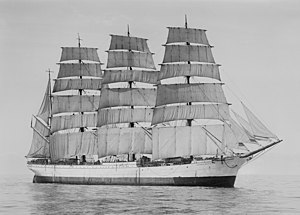Gustav Erickson

Herzogin Cecilie
|
|
| History | |
|---|---|
| Name: | Herzogin Cecilie |
| Owner: |
|
| Port of registry: | |
| Builder: | Rickmers Schiffbau AG, Bremerhaven |
| Yard number: | 122 |
| Launched: | 22 April 1902 |
| Completed: | 7 June 1902 |
| Out of service: | 25 April 1936 |
| Identification: | |
| General characteristics | |
| Tonnage: |
|
| Length: | 334 ft 8 in (102.01 m) |
| Beam: | 46 ft 3 in (14.10 m) |
| Height: | 175 ft 6 in (53.49 m) |
| Draught: | 24 ft 2 in (7.37 m) |
| Propulsion: | sails |
| Sail plan: | 4-masted barque, 38,000 square feet (3,530 m2) sail area |
| Crew: |
|
Herzogin Cecilie was a German-built four-mast barque (windjammer), named after German Crown Princess Duchess Cecilie of Mecklenburg-Schwerin (1886–1954), spouse of Crown Prince Wilhelm of Prussia (1882–1951) (Herzogin being German for Duchess). She sailed under German, French and Finnish flags.
Herzogin Cecilie was built in 1902 by Rickmers Schiffbau AG in Bremerhaven. She was yard number 122 and was launched on 22 April 1902. Completion was on 7 June that year. She was 334 feet 8 inches (102.01 m) long, with a breadth of 46 feet 3 inches (14.10 m) and a draught of 24 feet 2 inches (7.37 m).Herzogin Cecilie was built for Norddeutscher Lloyd Bremen. Unlike other contemporary German merchant sailing ships, the black Flying-P-Liners or the green ships of Rickmers, she was painted in white. She was one of the fastest windjammers ever built: she logged 21 knots at Skagen.
The tall ships of the time remained competitive against the steamers only on the longer trade routes: the Chilean nitrate trade, carrying salpeter from Chile to Europe, and the Australian wheat trade, carrying grain from Australia to Europe. Both routes required rounding Cape Horn routinely, and were not well suited for steamers, as coal was in short supply there.
Herzogin Cecilie was one of the fastest merchant sailing ships of her time, on a par with the Flying-P-Liners. The trip around Cape Horn from Portland (Oregon) to The Lizard (England) was done in 1903 in only 106 days.
...
Wikipedia
